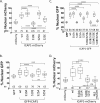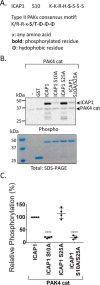Serine phosphorylation of the small phosphoprotein ICAP1 inhibits its nuclear accumulation
- PMID: 32005669
- PMCID: PMC7062153
- DOI: 10.1074/jbc.RA119.009794
Serine phosphorylation of the small phosphoprotein ICAP1 inhibits its nuclear accumulation
Abstract
Nuclear accumulation of the small phosphoprotein integrin cytoplasmic domain-associated protein-1 (ICAP1) results in recruitment of its binding partner, Krev/Rap1 interaction trapped-1 (KRIT1), to the nucleus. KRIT1 loss is the most common cause of cerebral cavernous malformation, a neurovascular dysplasia resulting in dilated, thin-walled vessels that tend to rupture, increasing the risk for hemorrhagic stroke. KRIT1's nuclear roles are unknown, but it is known to function as a scaffolding or adaptor protein at cell-cell junctions and in the cytosol, supporting normal blood vessel integrity and development. As ICAP1 controls KRIT1 subcellular localization, presumably influencing KRIT1 function, in this work, we investigated the signals that regulate ICAP1 and, hence, KRIT1 nuclear localization. ICAP1 contains a nuclear localization signal within an unstructured, N-terminal region that is rich in serine and threonine residues, several of which are reportedly phosphorylated. Using quantitative microscopy, we revealed that phosphorylation-mimicking substitutions at Ser-10, or to a lesser extent at Ser-25, within this N-terminal region inhibit ICAP1 nuclear accumulation. Conversely, phosphorylation-blocking substitutions at these sites enhanced ICAP1 nuclear accumulation. We further demonstrate that p21-activated kinase 4 (PAK4) can phosphorylate ICAP1 at Ser-10 both in vitro and in cultured cells and that active PAK4 inhibits ICAP1 nuclear accumulation in a Ser-10-dependent manner. Finally, we show that ICAP1 phosphorylation controls nuclear localization of the ICAP1-KRIT1 complex. We conclude that serine phosphorylation within the ICAP1 N-terminal region can prevent nuclear ICAP1 accumulation, providing a mechanism that regulates KRIT1 localization and signaling, potentially influencing vascular development.
Keywords: ICAP1 (integrin cytoplasmic domain-associated protein-1); KRIT1 (Krev interaction trapped); cell compartmentalization; cerebral cavernous malformation; nuclear import; nuclear translocation; nuclear transport; nucleocytoplasmic shuttling; phosphoprotein; phosphorylation.
© 2020 Su et al.
Conflict of interest statement
The authors declare that they have no conflicts of interest with the contents of this article
Figures










Similar articles
-
Protein kinase Cα regulates the nucleocytoplasmic shuttling of KRIT1.J Cell Sci. 2021 Feb 4;134(3):jcs250217. doi: 10.1242/jcs.250217. J Cell Sci. 2021. PMID: 33443102 Free PMC article.
-
Nuclear Localization of Integrin Cytoplasmic Domain-associated Protein-1 (ICAP1) Influences β1 Integrin Activation and Recruits Krev/Interaction Trapped-1 (KRIT1) to the Nucleus.J Biol Chem. 2017 Feb 3;292(5):1884-1898. doi: 10.1074/jbc.M116.762393. Epub 2016 Dec 21. J Biol Chem. 2017. PMID: 28003363 Free PMC article.
-
Mechanism for KRIT1 release of ICAP1-mediated suppression of integrin activation.Mol Cell. 2013 Feb 21;49(4):719-29. doi: 10.1016/j.molcel.2012.12.005. Epub 2013 Jan 11. Mol Cell. 2013. PMID: 23317506 Free PMC article.
-
Cocrystal structure of the ICAP1 PTB domain in complex with a KRIT1 peptide.Acta Crystallogr Sect F Struct Biol Cryst Commun. 2013 May 1;69(Pt 5):494-8. doi: 10.1107/S1744309113010762. Epub 2013 Apr 27. Acta Crystallogr Sect F Struct Biol Cryst Commun. 2013. PMID: 23695561 Free PMC article.
-
Interaction between krit1 and icap1alpha infers perturbation of integrin beta1-mediated angiogenesis in the pathogenesis of cerebral cavernous malformation.Hum Mol Genet. 2001 Dec 1;10(25):2953-60. doi: 10.1093/hmg/10.25.2953. Hum Mol Genet. 2001. PMID: 11741838
Cited by
-
KRIT1: A Traffic Warden at the Busy Crossroads Between Redox Signaling and the Pathogenesis of Cerebral Cavernous Malformation Disease.Antioxid Redox Signal. 2023 Mar;38(7-9):496-528. doi: 10.1089/ars.2021.0263. Epub 2022 Nov 1. Antioxid Redox Signal. 2023. PMID: 36047808 Free PMC article. Review.
-
p21-Activated Kinase: Role in Gastrointestinal Cancer and Beyond.Cancers (Basel). 2022 Sep 28;14(19):4736. doi: 10.3390/cancers14194736. Cancers (Basel). 2022. PMID: 36230657 Free PMC article. Review.
-
ICAP-1 loss impairs CD8+ thymocyte development and leads to reduced marginal zone B cells in mice.Eur J Immunol. 2022 Aug;52(8):1228-1242. doi: 10.1002/eji.202149560. Epub 2022 May 13. Eur J Immunol. 2022. PMID: 35491946 Free PMC article.
-
Signalling through cerebral cavernous malformation protein networks.Open Biol. 2020 Nov;10(11):200263. doi: 10.1098/rsob.200263. Epub 2020 Nov 25. Open Biol. 2020. PMID: 33234067 Free PMC article. Review.
-
Protein kinase Cα regulates the nucleocytoplasmic shuttling of KRIT1.J Cell Sci. 2021 Feb 4;134(3):jcs250217. doi: 10.1242/jcs.250217. J Cell Sci. 2021. PMID: 33443102 Free PMC article.
References
-
- Faurobert E., Rome C., Lisowska J., Manet-Dupé S., Boulday G., Malbouyres M., Balland M., Bouin A.-P., Kéramidas M., Bouvard D., Coll J.-L., Ruggiero F., Tournier-Lasserve E., and Albiges-Rizo C. (2013) CCM1–ICAP-1 complex controls β1 integrin–dependent endothelial contractility and fibronectin remodeling. J. Cell Biol. 202, 545–561 10.1083/jcb.201303044 - DOI - PMC - PubMed
Publication types
MeSH terms
Substances
Grants and funding
LinkOut - more resources
Full Text Sources
Molecular Biology Databases
Research Materials

